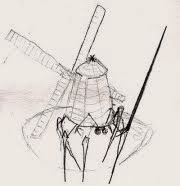Another feature that most reconstructers of the Nautilus miss is the triangular cross-section at the bow. The Nautilus was equipped with a ram, which was capable of leaving a triangular hole two meters across. This width leads me to beleive that while the Nautilus's midships crosssection is circular, the ram is not, and the two forms blend into each other.
The hole punched in the Scotia's hull is described as two and a half meters below her waterline, but Nemo comments that he was submerged two meters below the surface when the collision occurred. This means the Nautilus's centerline was more than six meters deep. So like a U-Boat, the bow rises upwards.
Nemo never hesitates to use the Nautilus as a ram. This means that he would have removed every possible feature that would have jammed or hung up if a ram attack failed to drive the Nautilus completely through her enemy.
The other critical detail is that when on the surface, the Nautilus is frequently mistaken for the back of a great whale. This error of identity continues under a variety of sightings until Aronnax, Land, and Conseil actually climb aboard it!
This means that no windows or portholes are visible. All our adventurers can find is two rings, presumably the lifting points for the wheelhouse and the lighthouse. The railing telescopes down into the hull. The hatch is almost invisible.
skip to main |
skip to sidebar
About Me
Blog Archive
-
▼
2007
(37)
-
▼
January
(7)
- Just watched Conan the Barbarian. It crys out for ...
- Lego as atoms...The smallest possible lego is a le...
- Strength and Weakness;Lego's secret weakness... At...
- Fitting the ViviCam 3826 with a stop between the l...
- Its probably not a good idea to place one's camera...
- Lady Frankenstein...For years, I called my compute...
- Another feature that most reconstructers of the Na...
-
▼
January
(7)


No comments:
Post a Comment